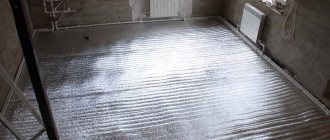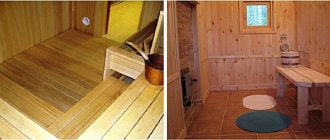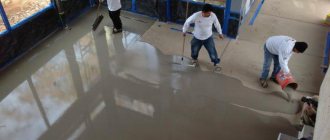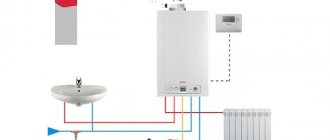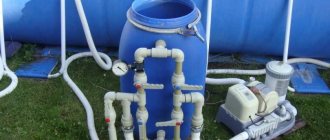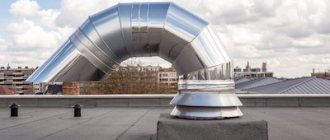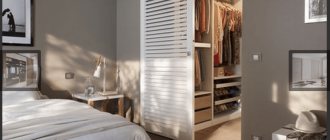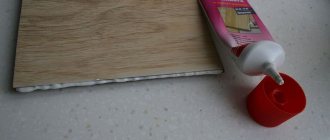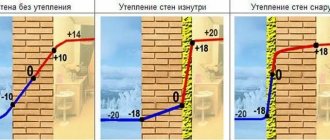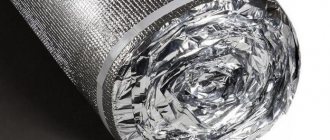The practice of using different types of insulation shows that, in addition to heat-insulating qualities, the environmental friendliness of the material and the release of dust and volatile substances are also important. In this case, insulating walls with penofol from the inside is beyond competition. Working with the material is a pleasure, because it is simply foamed polyethylene with an additional layer of aluminum foil. Dusty mineral wool or crumbling electrified foam is clearly inferior to penofol.
There is no better material for insulation from the inside
Which penofol is best to use for wall insulation?
It is clear that a universal heat insulator for gluing rooms from the inside has not yet been invented. Each insulation method has its own disadvantages and advantages, and penofol is no exception. On the building materials market you can buy penofol itself of three brands, A, B, C, as well as many of its fakes and imitations, both domestic and Chinese.
It’s easy to spot a fake insulation fabric. Firstly, such polyethylene foam burns like matches, and secondly, instead of expensive aluminum foil, counterfeits use metallized coating.
When choosing a suitable brand of insulating walls with penofol from the inside with your own hands, you must take into account the original purpose of the canvas:
- Grade A - foamed polyethylene with one-sided foil covering. Grade B - with double-sided aluminum gluing, grade C - single-sided polyethylene foam with one-sided foil and the presence of an adhesive layer to simplify installation on walls and floors;
- The material practically does not allow water vapor to pass through, its permeability is no more than 0.001 mg/m*h*Pa. Therefore, insulating walls inside a house with penofol can be equated to gluing with waterproofing or thick plastic film.
There is one more nuance that few people remember when choosing penofol with foil as insulation for walls. The thickness of the material is relatively small, 4-15 mm. Industrial samples of penofol can be up to 24 mm thick.
Simply laying penofol on the wall will not provide any special advantages, since the insulation power of 4-10 mm is clearly not enough for complete thermal insulation. The thermal conductivity coefficient of foamed polyethylene is only slightly better than expanded polystyrene, so a thin panel simply glued from the inside to the wall will not give the insulation effect that foam plastic or mineral wool of 25-50 mm will provide.
Important! The trick to using penofol is to glue it from the inside to the wall, leaving an air gap 10-12 mm thick.
Only in this case, a sandwich of two panels of penofol with two air gaps can provide insulation that is equal in efficiency to a 50 mm mineral wool slab. And if the room is also heated by a stove, potbelly stove, electric heater or infrared heaters, then the efficiency of penofol laid on the walls increases by 20-30%. For convective methods of heating rooms, the reflective properties of penofol insulation are not so pronounced.
A little about the manufacturer
When talking about Tepofol insulation, it is generally correct to capitalize the name. After all, this is not the name of the material, but of the company that produces it. The situation with penofol is similar, since we are talking about a trademark.
The Tepofol brand was registered by the company of the same name, Tepofol LLC. This happened in 2004.
The company's production began with the design and practical use of a laminator for applying a reflective layer to a surface based on polyethylene foam.
Tepofol became the founder of a completely new category of thermal insulation materials. It uses non-crosslinked polyethylene foam, as well as seamless insulation technology.
Now Tepofol is not just the first, but the leading manufacturer in Russia, engaged in the segment of roll insulation materials with patented interlocking technology. Moreover, in this regard, the company is the only one in Russia.
Speaking of Penofol. Unlike the Penofol company, the manufacturer Tepofol deals exclusively with foamed polyethylene, as well as products based on it.
Preparing walls before insulation
The amount of preparatory work depends on the surface material and the purpose of the structure, whether it is an internal partition, or whether insulation is needed from the inside along the main walls. And, of course, on the method of attaching penofol to the wall.
The simplest case is an internal wall; it is often necessary to do additional insulation if a wall separates a warm room from a closed but unheated space, as in the case of a loggia, balcony or a garage built into a house. The surface of the walls for laying penofol from the inside is simply cleaned, painted with water-based emulsion or treated with an antifungal vitriol solution.
A more common insulation scheme is to lay penofol from the inside on the walls of the balcony itself or any other similar room. In this case, the rough surface of the wall must be coated with waterproof varnish. If you plan to glue insulation, the supporting surface must be smooth.
The third option is to lay penofol from the inside onto the main walls, which provide primary insulation due to its own mass. It doesn’t matter whether it is a brick, a concrete wall or a wooden frame, if there is a structural thickness of 10-25 cm, the walls already provide an initial level of insulation, which allows you to move the dew point inside the masonry or slab. In this case, it is best to cover the inside of the walls with steam-permeable or “breathable” latex paint.
Is polyethylene foam effective as a thermal insulator substrate in a Warm Floor system?
And now I turn, in fact, to the actual study of the use of polyethylene foam as a heat insulator and substrate for pipes and underfloor heating cables. As I said above, it is not always possible to increase the thickness of the screed using expanded polystyrene. Often only 3-5 mm are left for insulation. And then foil polyethylene foam comes into play.
In my basement, I used extruded polystyrene foam from Techno-Nikol, since the ground below is cold. But when installing a heated floor between the first and second floors, I seriously thought about it. By and large, completely cutting off the downward flow of heat in my case was not at all necessary. After all, the ground floor is residential and heated. In addition, a 30 mm layer of polystyrene foam with installation on my area cost about 26,000 rubles. So I decided not to use foam. Having a warm ceiling in your own heated basement is not at all superfluous. But should you use a polyethylene foam backing? The costs are significantly lower, but they exist nonetheless. Is this a waste of money or does a thin layer of polyethylene foam insulate the downward heat flow to some extent. All heating in my house is automated and divided into zones and circuits with individual regulation. From an automation point of view, this means that it is better to minimize the influence of underfloor heating on the ground floor on the heating of the basement, since the nature of the heating is different. For example, in the basement, due to the large inertia of the soil, the heating is always turned on last in the fall. An acute question arose whether to spend 5-6 thousand on several rolls of polyethylene foam for TP or not. Does it work or not? In such cases, I often resort to the help of the Internet...
How to glue penofol to the wall
Most problems with laying thermal insulation arise precisely because of the wrong choice of adhesive. The problem is that the base of penofol is polyethylene, a fairly plastic substance with extremely low adhesion, so low that sliding bearings are even made from it. The best solution would be to use penofol “C”, it has an adhesive layer on the back side, like adhesive tape, so the insulation can be glued from the inside to a well-cleaned and dust-free smooth surface, to metal or plastic; the adhesive base will not stick to concrete.
It is clear that conventional water-soluble adhesive compositions are not suitable for installing insulation even in relatively comfortable conditions from inside the room.
The exception is acrylic resins. To install penofol on wooden walls, it is recommended to use acrylic glue, and only because when it dries it turns into a waterproof form.
For all other cases, you can use the most proven brands of glue:
- Based on Nairit. For example, “Nairit-1” or “88 Luxe”;
- Neoprene adhesives, the most convenient spray will be “Neoprene-2136”;
- Polyurethane compositions type UR600;
- Any adhesives based on polyisobutylene.
The latter are considered the most durable and resistant to moisture. The only negative is the high cost of the adhesive composition, so it is used mainly for gluing or repairing penofol panels.
Many experts believe that laying the panel from the inside of the room using glue is the only correct solution. You can, of course, fix penofol to the wall with self-tapping screws, but only on the condition that the thermal insulation panel is covered with an additional layer of polystyrene foam or mineral wool. The strength of penofol is low, and over time the metal heads will cut polyethylene foam like a knife.
For your information! Metal fasteners also pose a threat of cold bridges.
Preparatory work
First, you need to properly prepare the concrete for gluing, which will ensure a monolithic, uniform connection. They eliminate all defects, unevenness, cover up cracks, repair chips, and thoroughly clean the surface from dirt and dust. Cover the base with a primer and wait until it dries completely. All metal elements must be treated with an anti-corrosion compound.
Gluing stage
The glue is applied to the side without foil in a thin, even layer, spreading evenly over the entire surface. The edges are impregnated with glue as thoroughly as possible so that the penofol does not lag behind the concrete surface. The insulation must be held for 10-40 seconds so that the adhesive composition can set and fix the sheet to the surface more efficiently. Next, the sheet is pressed against the concrete, carefully smoothed, distributed evenly, additionally gluing the seams.
Choosing a suitable adhesive for gluing penofol to concrete is a very important task that must be approached seriously. It is advisable not to skimp on the composition, since the strength, reliability, and durability of the fixation will depend on its compliance with the requirements and operating conditions.
How to glue penofol to the wall behind the battery
All of the listed brands of glue can be used to make reflective screens from foil polyethylene foam. Provided that the distance from the penofol glued to the wall to the heating device is at least 40-45 cm.
For a water heating battery, you have to use a different method:
- From inside a niche or just behind the radiator, we clean the space on the wall from dirt, wallpaper and paint residues;
- We cover the wall with acrylic primer;
- We cut out the required size sheet from the foam sheet;
- Using a mounting gun, we apply plumbing silicone sealant from the tube along the contour onto the wall so that a seam with a height of at least 7-8 mm is formed.
All that remains is to place penofol from the inside behind the battery and lightly press along the contour. To prevent the reflective sheet from falling off while the sealant dries, we temporarily fix the insulation to the wall with ordinary tape.
If everything is done correctly, there will be an air gap of several millimeters between the screen and the wall from the inside. This is more than enough to compensate for the expansion and contraction of polyethylene during strong and moderate heating of the battery. It is clear that the best screens are made from penofol with smooth foil.
Criterias of choice
The quality of thermal insulation depends on the correct selection of insulation. Therefore, when purchasing penofol, you should pay attention to the following parameters:
- Product type. For basic insulation, only material with double-sided foil coating is used. The purpose of penofol relative to its classification is also taken into account.
- Thickness of the thermal insulation sheet. This parameter is selected for ease of installation. The optimal option is considered to be a thickness of no more than 5 millimeters.
- Material size. Before purchasing, you should calculate the required amount of penofol. The value is determined based on the size of the roll, which on average contains 9 -18 square meters.
- Manufacturing technology. Chemically cross-linked penofol has the best technical characteristics.
- Quality foil coating. The reflective properties of the insulation depend on the thickness of the aluminum coating and the purity of the material used.
- Uniformity of the material. The fabric should not have any stripes or stains. You can check this by unrolling the roll and looking through it at the light.
An important criterion for choosing penofol is its manufacturer. Reliable thermal insulation protection can be provided by material from well-known brands whose product quality meets the stated requirements.
How to properly lay and attach penofol to the wall
Insulation with foamed foil polyethylene makes sense only if there is an air gap between the wall and the thermal insulation sheet. For cold rooms, the dew point will fall within this period. Accordingly, water condensation will fall out from the inside on the aluminum foil and be removed through vents in the upper part of the walls.
What tools and materials will be needed
To perform insulation, first of all, you will need penofol itself, aluminized tape and a stationery knife. The canvas turns out to be quite capricious when cutting, so any unnecessary cuts or accidental damage to the surface must be “treated” in a timely manner.
To assemble the sheathing you need:
- Wooden slats 20x20 mm, the footage is calculated based on the step of laying on the wall of at least 50-60 cm;
- Self-tapping screws or mounting mushrooms used for fastening polystyrene foam insulation;
- Polyurethane adhesive, polyurethane foam.
To work, you will also need carpentry tools, a tape measure, and a jigsaw. As a rule, a certain amount of plastic or pine lining is purchased immediately. Leaving penofol insulation open is risky due to possible accidental damage to the fabric, and in addition, an additional air gap from inside the lining will only improve the quality of thermal insulation.
Which side should you lay and attach foil penofol to the walls?
In all schemes for insulating a room from the inside, foil thermal insulation is laid with the aluminum surface facing up. It doesn’t matter that wooden or plastic wall cladding will be packed over the laid penofol; for infrared thermal radiation emanating from a heater or a hot stove, this does not matter at all. Radiant heat penetrates much deeper, approximately 5-7 cm, so a warm zone is formed under the lining from the inside, providing heating and removal of water vapor beyond the insulation layer.
The canvas can be mounted on walls vertically or horizontally, the main thing is to connect the edges end-to-end, not overlapping, and be sure to glue them with aluminized tape.
How to lay and attach penofol to a wooden wall
Most often it is necessary to resort to insulation of plank, timber and log buildings. In order to insulate a box made of logs or timber from the inside, you have to assemble a floating sheathing. This means that the vertical slats are attached to the wall through movable joints.
Next, the canvas is glued horizontally onto the slats and sealed at the joints with tape. The next step is to sew on the counter-lattice, this time with horizontal slats or a profile. All that remains is to lay the clapboard.
For wooden buildings and log cabins that have undergone shrinkage, foam insulation can be done using only horizontal slats.
How to lay and attach penofol to a concrete wall
Foil thermal insulation is also mounted through the intermediate frame of the sheathing. Only for a concrete wall it is better to use larch slats, and choose double-sided penofol.
Concrete practically does not allow vapor to pass through, but has high thermal conductivity, so the dew point will be inside the insulation on the aluminum foil. Therefore, it is best to glue slats and penofol onto concrete, only hammering one dowel in the upper part on the ends. The sheathing is attached to the wall with mounting foam, and penofol with polyurethane glue with a slight tension on the panel.
What is it needed for
The main feature of penofol is the presence of a heat-reflecting screen. It is indispensable for insulation:
- walls and ceilings as part of multilayer enclosing structures;
- balconies and loggias;
- pitched roofs, attics and attics;
- utility rooms and outbuildings;
- greenhouses;
- heat-reflecting screen as part of a heated floor system;
- niches with an installed heating radiator;
- air conditioning systems for freezing units;
- pipes and lines with refrigerant or coolant within the permissible operating temperatures.
In addition to its thermal insulation and heat-reflecting properties, penofol has practically zero vapor permeability. It is used for effective and unique waterproofing properties as part of a roofing pie. H only from the inside of the attic or attic.
Covering all the advantages, penofol is ideal for arranging insulated heat-efficient rooms: greenhouses, incubators, vegetable stores, for protecting basements and semi-basements.
Thanks to the hermetic closed structure of polyethylene foam, penofol has good soundproofing properties. Basically, it absorbs shock sound and vibration well, but is less resistant to high-frequency sounds and noise.
As an underlay for flooring, as well as under a thin screed, it will absorb the sound of footsteps or impacts on the floor.
Floor insulation. Under the screed
When insulating floors, penofol is used as a substrate for all types of screeds, wet, semi-dry, dry, bulk or made with any sheet material, as well as as a substrate for all types of floor coverings.
This is facilitated by the high compressive strength of the material and the dynamic modulus of elasticity is much higher than that of any other insulation.
Floor insulation scheme
Polyethylene ensures the strength of air bubbles, which in turn provides uniform shock absorption to any distributed loads.
Taking into account the horizontal distribution of penofol, it is not necessary to attach it additionally to the base.
When installing a heated floor or fixing a reinforcing layer, any damage to the surface of the penofol should be minimized so as not to violate the integrity of the foil layer.
Balcony insulation
For insulating a balcony, penofol is an ideal thermal insulation material. In conditions of extremely limited space, it will be necessary to subtract only 20 mm from each fence in order to insulate the room with penofol, taking into account the required gap between the insulation and the finishing to form a closed air chamber.
Two installation options are used:
- Uniform laying of the material end-to-end over the entire insulated surface and installation of sheathing for further finishing on top of it;
- First, a sheathing made of 40x40 mm timber is attached, and then insulation is distributed in each cell, extending onto the sheathing elements.
Balcony insulation scheme
In both options, there is no need to use adhesives or a large number of fasteners. In the first case, the insulation will be securely pressed to the base by the sheathing, and in the second case, it is enough to attach the penofol under the very base with a stapler to the same sheathing.
The choice of the optimal option is determined based on the required load capacity of the sheathing and the weight of further finishing.
Insulation of walls with penofol from the outside
When installing thermal insulation on external surfaces, foamed foil polyethylene is often used as additional insulation under mats made of mineral fiber or expanded polystyrene.
Penofol is rarely used in its “pure” form due to its low mechanical strength, but sometimes it is simply irreplaceable. For example, for temporary structures and buildings located in areas with a pronounced continental climate. It's cold at night, hot during the day.
The outer layer of insulation should “look” outward and be sure to leave a gap between the brick and the penofol
Therefore, the insulation is carried out in two layers; from the inside, the thermal insulation is laid out with ordinary A-penofol, with foil inside the room. The outer layer of penofol is attached with fungi to the sheathing; as a rule, it is a double-sided perforated material with a protective film applied over aluminum. The thickness of the outer insulation layer is at least 15 mm.
What is foil insulation
Foil insulation is a combined material consisting of heat-insulating raw materials and a metallized layer. The reflective coating is installed on 1 or 2 sides at once.
Foil reflects thermal energy back into the room, which is why this insulation is thinner than other materials.
Aluminum film has increased reflectivity, and metallized film has good resistance to alkali.
Recommendations and common mistakes
The most common mistake in installing thermal insulation is the excessive use of self-tapping screws and staplers to fasten the sheet. At the same time, the penofol layer is also deliberately stretched to obtain an even plane. As a result, the panel breaks and the integrity of the insulation is compromised.
The lining is fastened so that a second air gap remains, and the screws do not reach the penofol panel
If it is not possible to use glue, then the material is fastened to the sheathing with thin upholstery nails 20-25 mm and be sure to drive them through a wooden batten. The fabric is secured in the same way when laying the roof insulation from the inside.
Ceiling insulation
Penofol allows you to insulate the ceiling in the best possible way, since the material is thin and light in weight. In addition, its installation will require minimal effort.
Ceiling insulation with foam insulation
Before insulation, you will need to ensure that you have:
- penofol;
- wooden slats;
- hardware;
- metalworking tools;
- cladding.
Execution technology
- Thermal insulation of the ceiling surface is provided in two steps. The initial layer is fixed to the ceiling by means of slats in the longitudinal direction. The next layer is similar in the transverse direction, with the material extending onto the walls within 100mm. The slats are secured with self-tapping screws.
- A cladding made of plastic, foam, or other lightweight component is installed on top of the installed layers.
Life time
Since foil insulation appeared relatively recently, it is not yet possible to determine the exact expiration date. However, after conducting experiments, we can say that the material does not lose its properties for 200 years.
The service life of the installed insulation depends on the adhesive used. If the adhesive composition has passed its expiration date, then you can re-install it with the same heat insulator.
There are a lot of insulation materials on the construction market. The choice is so wide that the question arises, which is better. To answer, you need to compare the characteristics of the thermal insulation material and the scope of application - street, living room, garage or agricultural building.
The most popular type of insulation with foil for interior finishing is aluform
Bestizol or alufom is a bubble base consisting of aluminum foil (outer layer) and polyethylene (inner layer) on one side. The foil acts as a reflector of solar and heat rays. The polyethylene layer has a cellular structure and neutralizes sound waves and shocks. The advantage of this material is low thermal conductivity.
Bestizol can be used in both cold and hot weather. Due to its small thickness (1 cm), the material is used for hard-to-reach places:
- for winding ventilation pipes;
- air duct coverings;
- insulation of pipelines and other outlet communications.
